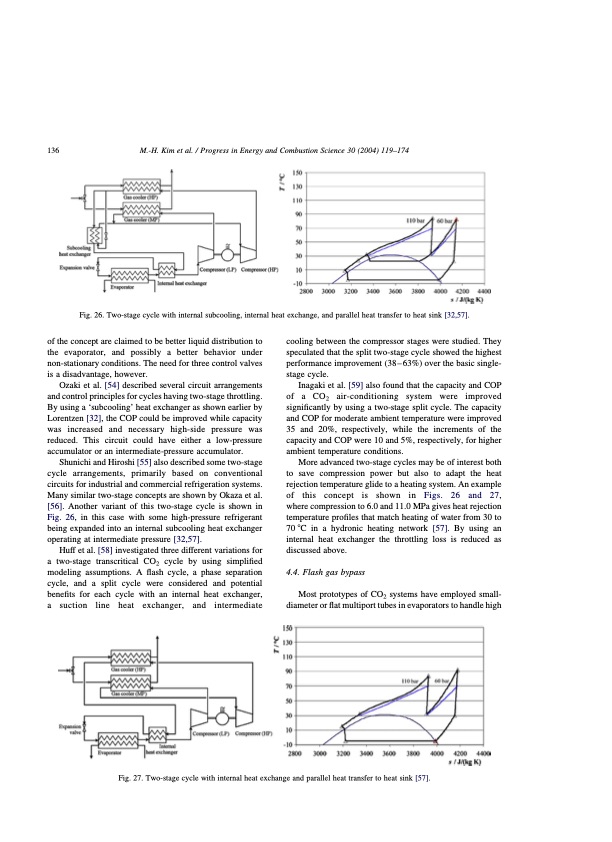
PDF Publication Title:
Text from PDF Page: 018
136 M.-H. Kim et al. / Progress in Energy and Combustion Science 30 (2004) 119–174 Fig. 26. Two-stage cycle with internal subcooling, internal heat exchange, and parallel heat transfer to heat sink [32,57]. of the concept are claimed to be better liquid distribution to the evaporator, and possibly a better behavior under non-stationary conditions. The need for three control valves is a disadvantage, however. Ozaki et al. [54] described several circuit arrangements and control principles for cycles having two-stage throttling. By using a ‘subcooling’ heat exchanger as shown earlier by Lorentzen [32], the COP could be improved while capacity was increased and necessary high-side pressure was reduced. This circuit could have either a low-pressure accumulator or an intermediate-pressure accumulator. Shunichi and Hiroshi [55] also described some two-stage cycle arrangements, primarily based on conventional circuits for industrial and commercial refrigeration systems. Many similar two-stage concepts are shown by Okaza et al. [56]. Another variant of this two-stage cycle is shown in Fig. 26, in this case with some high-pressure refrigerant being expanded into an internal subcooling heat exchanger operating at intermediate pressure [32,57]. Huff et al. [58] investigated three different variations for a two-stage transcritical CO2 cycle by using simplified modeling assumptions. A flash cycle, a phase separation cycle, and a split cycle were considered and potential benefits for each cycle with an internal heat exchanger, a suction line heat exchanger, and intermediate cooling between the compressor stages were studied. They speculated that the split two-stage cycle showed the highest performance improvement (38 – 63%) over the basic single- stage cycle. Inagaki et al. [59] also found that the capacity and COP of a CO2 air-conditioning system were improved significantly by using a two-stage split cycle. The capacity and COP for moderate ambient temperature were improved 35 and 20%, respectively, while the increments of the capacity and COP were 10 and 5%, respectively, for higher ambient temperature conditions. More advanced two-stage cycles may be of interest both to save compression power but also to adapt the heat rejection temperature glide to a heating system. An example of this concept is shown in Figs. 26 and 27, where compression to 6.0 and 11.0 MPa gives heat rejection temperature profiles that match heating of water from 30 to 70 8C in a hydronic heating network [57]. By using an internal heat exchanger the throttling loss is reduced as discussed above. 4.4. Flash gas bypass Most prototypes of CO2 systems have employed small- diameter or flat multiport tubes in evaporators to handle high Fig. 27. Two-stage cycle with internal heat exchange and parallel heat transfer to heat sink [57].PDF Image | CO2 Vapor Compression Systems

PDF Search Title:
CO2 Vapor Compression SystemsOriginal File Name Searched:
co2-vapor-compression-systems.pdfDIY PDF Search: Google It | Yahoo | Bing
CO2 Organic Rankine Cycle Experimenter Platform The supercritical CO2 phase change system is both a heat pump and organic rankine cycle which can be used for those purposes and as a supercritical extractor for advanced subcritical and supercritical extraction technology. Uses include producing nanoparticles, precious metal CO2 extraction, lithium battery recycling, and other applications... More Info
Heat Pumps CO2 ORC Heat Pump System Platform More Info
| CONTACT TEL: 608-238-6001 Email: greg@infinityturbine.com | RSS | AMP |